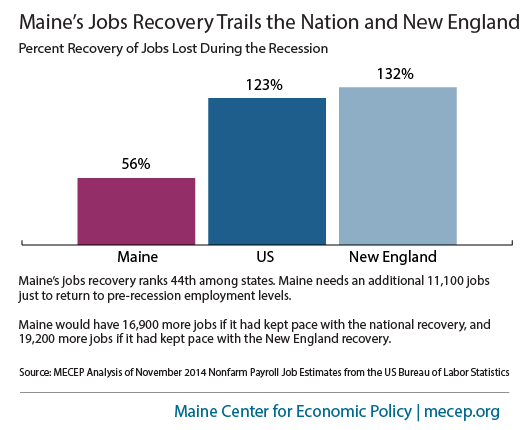Beyond the good news, bad news stories of businesses expanding or shuttering are broader trends that affirm a critical challenge that too many Maine families are facing: there just aren’t enough good paying jobs to go around. Today’s Maine jobs report from the U.S. Bureau of Labor Statistics (BLS) calls attention to this fact.
 For the month of November, Maine’s unemployment rate is 5.7%, roughly the same as the national rate of 5.8%. As we’ve written before, this figure masks the reality that many Maine people counted as “employed” are part-time workers who want full-time work but can’t find it. Another challenge with the traditional unemployment figure is that it does not include those folks who have given up looking for work but would likely re-enter the workforce if jobs were available.
For the month of November, Maine’s unemployment rate is 5.7%, roughly the same as the national rate of 5.8%. As we’ve written before, this figure masks the reality that many Maine people counted as “employed” are part-time workers who want full-time work but can’t find it. Another challenge with the traditional unemployment figure is that it does not include those folks who have given up looking for work but would likely re-enter the workforce if jobs were available.
That brings us back to the question of whether or not jobs are available. Scanning the want ads suggests that there are employers looking for workers. The problem in Maine is there aren’t enough employers hiring to make up for the jobs that we lost during the recession: for every job listed in the Maine Job Bank, there are five unemployed Mainers actively searching for work. We’re still well below pre-recession job levels.
Based on the BLS data, Maine has recovered 56% of jobs lost during the recession. Viewed in isolation, that appears to be a good thing: we’ve gained 14,100 jobs since the end of the recession. But adding 14,100 jobs over five years isn’t much of an accomplishment considering we lost more than 25,000 jobs during the recession.
Looking at how Maine’s job recovery compares to other states reveals an even more troubling picture. Today’s data reveals that Maine ranks 44th among states in the percentage of jobs recovered. By comparison, New England has recovered 132% of jobs and the United States has recovered 123%. That means if Maine had kept pace with New England job recovery levels, we would have 19,200 more jobs than we do today. Similarly, if Maine had kept pace with the U.S. level of recovery, we would have 16,900 more jobs.
It is reasonable to ask whether or not, even under the best of circumstances, Maine’s recovery could have kept pace with New England and the U.S. Slow population growth and aging baby boomers play some role in limiting Maine’s growth prospects. However, other states with similar demographic challenges (like Vermont and New Hampshire) have managed to exceed national job recovery levels. The real question is to what extent have our public policy choices in recent years undermined job growth? Refusing to use voter-approved bonds, failing to invest in education, turning away $120 million investment in renewable energy, and refusing to accept hundreds of millions of dollars in federal health care funds have all contributed to Maine’s back of the pack status.
Most Maine families could care less about where we rank compared to other states. They need good paying jobs now. Whether they connect the dots or not, the reality is that state policy choices in recent years have very real implications on the current availability of jobs.



